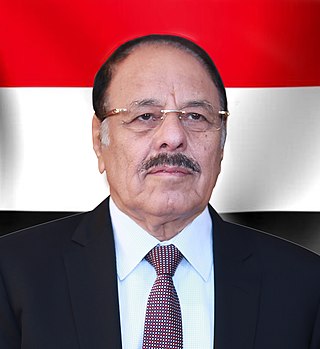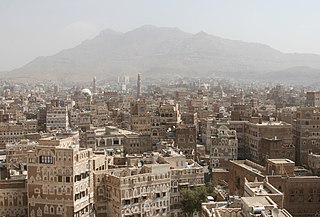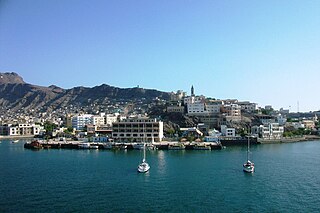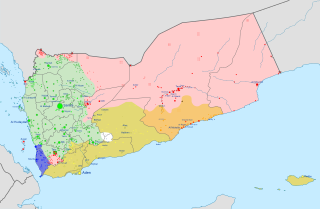
The Yemeni Armed Forces are the military forces of the Republic of Yemen. They include the Yemeni Army, Yemeni Navy and the Yemeni Air Force. The capital of the country, Sana’a is where the military is headquartered. Per the constitution of Yemen, the President of Yemen serves as the commander-in-chief.

Abdrabbuh Mansur Hadi is a Yemeni politician and former field marshal of the Yemeni Armed Forces who served as the president of Yemen from 2012 until 2022, when he stepped down and transferred executive authority to the Presidential Leadership Council, with Rashad al-Alimi as its chairman. He was the vice president to Ali Abdullah Saleh from 1994 to 2012.

Ali Mohsen Saleh al-Ahmar, sometimes spelled Muhsin, is a Yemeni military officer who served as the vice president of Yemen from 2016 to 2022, when he was dismissed by President Abdrabbuh Mansur Hadi, who transferred the powers of the president and vice president to the Presidential Leadership Council. He is a general in the Yemeni Army and was the commander of the northwestern military district and the 1st Armoured Division. He played a leading role in the creation of the General People's Congress.

The Houthi takeover in Yemen, also known as the September 21 Revolution, or 2014–15 coup d'état, was a popular revolution against Yemeni President Abdrabbuh Mansur Hadi led by the Houthis and their supporters that pushed the Yemeni government from power. It had origins in Houthi-led protests that began the previous month, and escalated when the Houthis stormed the Yemeni capital Sanaa on 21 September 2014, causing the resignation of Prime Minister Mohammed Basindawa, and later the resignation of President Abdrabbuh Mansur Hadi and his ministers on 22 January 2015 after Houthi forces seized the presidential palace, residence, and key military installations, and the formation of a ruling council by Houthi militants on 6 February 2015.

The Yemeni crisis began with the 2011–2012 revolution against President Abdullah Saleh, who had led Yemen for 33 years. After Saleh left office in early 2012 as part of a mediated agreement between the Yemeni government and opposition groups, the government led by Saleh's former vice president, Abdrabbuh Mansur Hadi, struggled to unite the fractious political landscape of the country and fend off threats both from Al-Qaeda in the Arabian Peninsula and from Houthi militants that had been waging a protracted insurgency in the north for years.

The Battle of Sanaa in 2014 marked the advance of the Houthis into Sanaa, the capital of Yemen, and heralded the beginning of the armed takeover of the government that unfolded over the following months. Fighting began on 9 September 2014, when pro-Houthi protesters under the command of Abdul-Malik al-Houthi marched on the cabinet office and were fired upon by security forces, leaving seven dead. The clashes escalated on 18 September, when 40 were killed in an armed confrontation between the Houthis led by military commander Mohammed Ali al-Houthi and supporters of the Sunni hardliner Islah Party when the Houthis tried to seize Yemen TV, and 19 September, with more than 60 killed in clashes between Houthi fighters and the military and police in northern Sanaa. By 21 September, the Houthis captured the government headquarters, marking the fall of Sanaa.

The aftermath of the Houthi takeover in Yemen refers to developments following the Houthis' takeover of the Yemeni capital of Sana'a and dissolution of the government, which eventually led to a civil war and the Saudi Arabian-led intervention in Yemen.

The Battle of Aden was a battle for the control of Aden, Yemen, between Houthis rebels and Yemen Army forces loyal to Ali Abdullah Saleh on one side, and Yemen Army units loyal to Abdrabbuh Mansur Hadi and Southern Movement militias on the other side.

The Yemeni civil war is an ongoing multilateral civil war that began in late 2014 mainly between the Rashad al-Alimi-led Presidential Leadership Council and the Mahdi al-Mashat-led Supreme Political Council, along with their supporters and allies. Both claim to constitute the official government of Yemen.

On 26 March 2015, Saudi Arabia, leading a coalition of nine countries from West Asia and North Africa, launched an intervention in Yemen at the request of Yemeni president Abdrabbuh Mansur Hadi, who had been ousted from the capital, Sanaa, in September 2014 by Houthi insurgents during the Yemeni Civil War. Efforts by the United Nations to facilitate a power sharing arrangement under a new transitional government collapsed, leading to escalating conflict between government forces, Houthi rebels, and other armed groups, which culminated in Hadi fleeing to Saudi Arabia shortly before it began military operations in the country.
Hussein Nagi Khairan is a Yemeni military officer. Until November 2016, he served as defense minister for the Houthi-appointed government of Yemen, having been appointed on 22 March 2015, after the defection of Mahmoud al-Subaihi to the internationally recognised government of Abd Rabbuh Mansur Hadi in Aden. According to a Houthi political official, Khairan's appointment placed him in direct command of all military units except for those loyal to Hadi. He reportedly took charge of the military offensive against Hadi's holdouts in southern Yemen.
The Battle of Dhale was a key fight for control of Dhale, Yemen, between the Houthis and Yemen Army units loyal to Ali Abdullah Saleh on one side, and militiamen and Yemen Army units loyal to Abd Rabbuh Mansur Hadi on the other side.

The Lahij insurgency was a guerrilla war in 2015 waged by tribesmen loyal to Abdrabbuh Mansur Hadi against the Houthis and Yemen Army units loyal to Ali Abdullah Saleh, who controlled most of the Lahij Governorate of Yemen. In late July, Pro-Hadi forces had launched an offensive to recapture Al Anad Air Base and rest of Lahij Governorate. On 4 August, Pro-Hadi forces had retaken full control of the Lahij Governorate.

The siege of Taiz is an ongoing, protracted military confrontation between opposing Yemeni forces in the city of Taiz for control of the city and surrounding area. The battle began one month after the start of the Yemeni Civil War.
The Battle of Port Midi refers to a battle during the Yemeni Civil War between the Saudi coalition-backed Hadi loyalists and the Houthi government. Although Hadi loyalists seized the port, the Houthi fighters along with the popular committees managed to conduct some attacks around Midi. The conflict also had spillovers in the rest of the Hajjah Governorate. On 26 January 2017, Hadi loyalists extended their control to Harad District in Hajjah Governorate.
The following is a timeline of the Yemeni civil war, which began in September 2014.

The Marib campaign, also called Marib offensive, is an ongoing military campaign in the Yemeni civil war for the control of the Marib Governorate of Yemen. Fighting between the Houthi forces and factions of the Yemeni Army loyal to Supreme Political Council on one side, and Yemeni Army units loyal to president Abdrabbuh Mansur Hadi and militiamen on the other side, has taken place since early 2015. Marib is rich in oil and gas resources and is a key strategic governorate because it connects the Houthi-controlled Sanaa and Alimi-controlled Hadhramaut governorates.

The Nihm Offensive was a military operation that began in mid-December 2015 in the District of Nihm, when government forces took control of "Mas camp" which borders the governorates of Al-Jawf, and Marib. On 19–20 December, government forces coming from Marib and al-Jawf, took control of the 312th Armored Brigade camp, and 334th Armored Brigade camp. Government forces faced fierce resistance that lasted until February 2016, when they were able to take control of the 312th Armored Corps camp.

The Al Jawf offensive was a Houthi offensive that began in February 2020 with clashes in the Al Jawf Governorate during the Second Yemeni Civil War. Houthi forces were able to decisively capture the town of Al Hazm on 1 March 2020 from the Hadi government. On 27 April, the first phase of the offensive ended with the Houthis capturing 3,500 square kilometers of territory in Al Jawf Governorate. After reinforcing, the Houthis launched the second phase of their offensive on 27 May, making further advances toward the city of Marib and capturing the Maas military base on 20 November, 2020. The Houthis halted the offensive on 5 February 2021, in order to account for changes in the Saudi-led coalition and Southern Transitional Council. After reinforcing once more, the Houthis launched a new offensive towards Marib city on 7 February.

The Battle of Marib is an ongoing battle that began in February 2021 following the advance of the Houthis towards the city of Marib, the capital of Marib Governorate in Yemen controlled by the Cabinet of Yemen.













